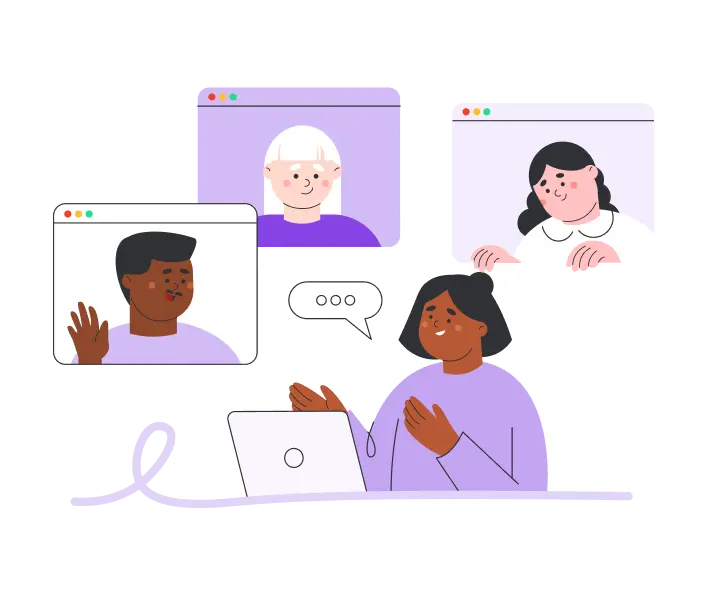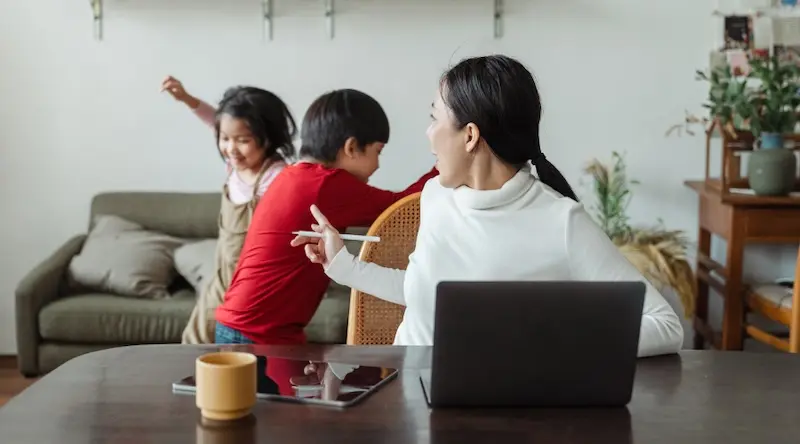settings
children
With Famly since
I’ve been working with children for over 30 years and I don’t think a day goes by where I don’t find myself in a power struggle with at least one child.
Nowadays, I try to back out when I sense a situation turning into a power struggle. But this happened over time, with many opportunities for me to learn from. One of the silliest power struggles I found myself in happened almost a decade ago.
I had a child-sized couch that fit perfectly in a small nook in the classroom. The power struggle started when a child figured out if they pulled the couch out, the space between the couch and the wall made a perfect hideout. But moving the couch back and forth was wearing out the rug and chipping the paint on the wall.
I tried to stop the children from pulling out the couch. But of course, they were more interested in playing than listening to me. I’m not sure why it bothered me so much. I think it was less about the rug and wall and more about feeling like the children were being defiant. It was me against them.
But when I stepped back and tried to see why they were so determined, I realized how creative they were. One day the space behind the couch was a treehouse. The next day it was a tent. As I appreciated their play, I thought of ways to help them. I was able to get a parent who worked as a contractor to install some wainscotting scraps to protect the wall and to trim the rug. Rather than work in opposition, I was on the same team as the children.
Over time, I realized these power struggles and issues of control were making my own job more stressful. All I needed to do was change my attitude, and my job became more enjoyable while also connecting more with children.

Reframe the problem to put everyone on the same team
This idea of being on the same team can help you as well when you find yourself in power struggles with children.
When children are engaging in a behavior that concerns you, you must reflect on the reason behind the behavior. You don’t need to know the exact reason. A parent being out of town may result in more physical aggression from a child. But if you were not aware of the family situation, you could still see a child trying to initiate interactions with others (even if the interaction was negative). You could also notice the child was feeling dysregulated without needing to know why.
Power struggles often stem from what we, as adults, perceive as disruptive behavior. When it comes to understanding disruptive behavior, I think there are four basic reasons for a child’s actions:
- Connecting with others
- Attempting to engage with materials
- Need for movement
- Feeling dysregulation and attempting to regulate
Being able to identify these reasons can help you focus on what the child’s goal is in a given behavior. Then you can choose a strategy that allows you to share the same goal. Down below, we’ll go through each of these reasons in depth, and talk about how you can offer a supportive, constructive response.
Understanding children's attempts at connection
Connecting with others is a basic human need. The phrase “serve and return” is often used to describe this interaction with others. Children attempt to connect using the skills they have, which sometimes results in behaviors that adults find challenging. Power struggles pop up when we feel children have broken our ground rules, or are displaying some negative behavior.
Children's attempts at connecting are often referred to as “seeking attention.” This label seems judgmental. We frame seeking attention as negative. But when we take this negative angle, we ignore what the child is attempting to do. A young child who wants to connect with peers may learn that saying the word “poop” gets a reaction. Another child may knock over a block building someone is working on to initiate an interaction.
Children can only use the tools they have to make connections. Trying to simply stop the behavior sets you up for a power struggle, because it doesn’t remove children’s need for connection — it only snuffs out their attempts to meet that need. This can be frustrating for children.
Instead, you can help them add new connection strategies to their repertoire, if you feel their current attempts are disruptive or problematic. The specific strategy will depend on the skill needed, but here are a few examples of how this works:
- Jonas really wants to get other children to laugh, but this often ends up in him interrupting other children, or disrupting quiet time. To solve this, let's help Jonas come up with silly rhymes or teach a few simple jokes. Help him understand the right moment to seek these laughs.
- Reina is looking to join other children in play, but her attempts end up annoying children who have their small play groups set up. We can help Reina play with the same materials nearby, or help her ask to join the other children before she dives right in.
- Yusra wants to connect with her friends, but this means she’s talking to them during quiet rest time. We might suggest that Yusra draw a picture for the other child, or give her a quiet way to form those same connections.
The big ideas

Solving power struggles by giving children more alternatives
Children engage with materials out of curiosity. For example, they may be curious about how far they could throw a block, but not fully able to picture the dangers of that choice. We want to enable children’s curiosity, but sometimes we need to step in because the child may not fully understand cause and effect.
In these cases, avoid simply redirecting them to an unrelated activity. Keep the verb in mind. If a child throws a block. Help them find something they can throw safely. “It looks like you would like to throw something. I’m worried someone could get hurt if you throw the block. Should we get a ball?”
Other times it may be more a question of timing. If they wanted to draw a picture in the middle of lunch, for example, that can be impractical to accommodate. But if we flat-out deny their creative impulse to draw, it can be frustrating and upsetting for a child, and set us up for a power struggle. Again, solving this is about recognizing children’s needs, and finding an enabling alternative.
You can address this with a predictable schedule and posting the schedule in picture form. Children are still developing the ability to make mental pictures. It is easier to understand when you show them rather than simply tell them they can draw later. “Let’s look at the schedule. You can draw after lunch.”
For younger children, you can make a “first/then” statement. “First lunch, then draw.”
Recognizing children’s need for movement
I have seen many power struggles that involved a child moving when an adult expects them to sit still. Movement is a natural part of development. Unfortunately, children in group settings are often given less opportunity to move. It is important to keep the need for movement in mind when planning your environment or schedule, so that children can get ‘brain breaks’ and engage in physical activity. It is also important to expect that some children will need more movement than others.
If you expect children to ‘sit still’ for most of the day, you’ll create a power struggle when those classroom rules run afoul of children’s natural active impulses.
Instead, here are a few ideas to enable children’s need for movement during the day:
- Create spaces for children to move both indoors and outdoors
- Make being outside a big part of the daily schedule
- Indoors, have a mat to designate a movement area
- Indoors, have pillows or rolled up socks that children can throw at each other
- Group activities involving all (or most) of the class should be focused on movement and music
- Save book reading to smaller groups or one-on-one
- Have sensory-rich materials (water, sand, clay, etc.) available daily
- Keep chairs stacked on the side to encourage children to move more, where children can still bring a chair over to a table if they wish

Dysregulation
Dysregulation in young children often expresses itself as a tantrum. When a child is upset, they need emotional support from a caregiver to soothe themselves. Children can’t use reasoning when they’re already in this tantrum state, so it’s not helpful to lecture them on what they should not do (hitting, yelling, knocking things down, etc). In many cases, this may in fact make them more upset.
Trying to ‘discipline’ children who are in a tantrum state, or highly agitated, sets you up for a power struggle. To solve this, you’ve got to step back, take a deep breath, and help the child return to a more stable, self-regulated state.
Within child development, this process is known as co-regulation. To learn more about it, and how it works, you can read my article on co-regulation right here. But in the moment, here are a few examples of what co-regulation looks like:
- You can name their emotion, talk about it, and sit with them.
- Once they are calm, you can talk to them about what made them upset.
- Depending on their age and development, you may be able to think of strategies to use next time something similar happens.
This process can require a lot of patience from educators, but it’s critical to helping children learn to understand and control their own emotions. Over time, they will pick up skills that will make dysregulation less frequent, thereby cutting down on tense moments that lead to power struggles in early childhood.
Anyone who works with children will find times when the adult's ideas are competing with a child’s ideas and intentions. It’s very easy to dig your heels in and insist on children bending to your ideas. I have found that my job is easier and more enjoyable when I stop to appreciate what the child is trying to do and find a way to support them rather than compete with them.
Free downloadable Early Childhood resources
Explore our library of longer-form books, guides and editable templates - all free to download.
Explore free resources







%20(2).png)
